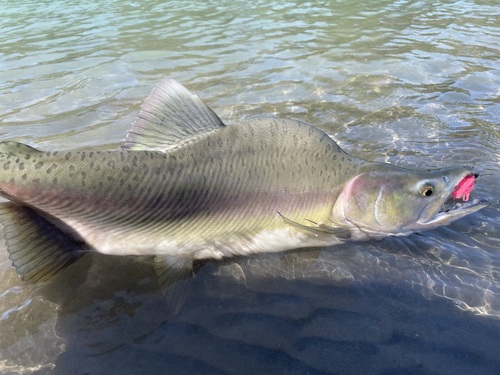
Pink Salmon
The Atlantic bluefin tuna (Thunnus thynnus) is a magnificent and highly migratory species of tuna renowned for its size, speed, and commercial value. It plays a crucial role in the marine ecosystem as a top predator. This species is also critically endangered due to overfishing.
3 3 years
Lifespan
38 - 76 cm
Length
Least Concern
Conservation Status
15 km/h
Swimming speed
Carnivorous, Planktivorous, Insectivorous
Diet
Highly Migratory, Anadromous
Migration
Appearance Overview
The Atlantic bluefin tuna is a large, streamlined fish with a metallic blue body and a silvery underside.
Coloration
Dark metallic blue on top, silvery underside
Body Shape
Torpedo-shaped, built for speed and endurance
Fins
Two dorsal fins, the first depressible; small finlets running down the back and belly to the tail
Length
Up to 13 feet (4 meters), commonly 6.5-8 feet (2-2.5 meters)
Weight
Up to 2,000 lbs (900 kg), commonly around 550 lbs (250 kg)
Diet
Carnivorous, feeding on a variety of fish (like mackerel, herring, and hake), squid, and crustaceans.
Feeding Behavior
Highly active predator, using speed and agility to hunt. Often hunts cooperatively, corralling prey into tight balls.
Social Behavior
Forms large schools, especially when young. Schools can be mixed with other tuna species. Highly migratory, capable of crossing entire oceans.
Commercial Relevance
Extremely high value, particularly in the Japanese sushi and sashimi market. One of the most expensive fish in the world.
Conservation measures
International fishing quotas, regional fishing closures, minimum size limits, and efforts to improve fishing gear selectivity.
Status
Endangered (IUCN)
Threats
Severe overfishing (driven by demand for sushi), bycatch in other fisheries, and potentially climate change impacts on prey distribution.
Habitat Distribution
Depth Range
0-1,000 meters (0-3,280 feet), but most common in surface waters to 200 meters (656 feet)
Geographic Range
Western and Eastern Atlantic Ocean, including the Mediterranean Sea. Absent from the Black Sea.
Preferred Environment
Temperate and subtropical waters; prefers open ocean but can also be found in coastal areas, particularly during spawning.
Reproduction and Life Cycle
Breeding Habits
Spawns in two main areas: the Mediterranean Sea and the Gulf of Mexico. Spawning occurs in warm waters during specific seasons (May-June in the Gulf of Mexico, June-July in the Mediterranean).
Development Stages
Eggs are pelagic (free-floating). Larvae hatch and develop rapidly, feeding on plankton. Juveniles grow quickly, forming schools. The fish continues to grow throughout its life.
Fecundity
Highly fecund; a large female can produce up to 30 million eggs per spawning season. Egg production is related to the size of the female.
Maturity Age
Matures at different ages depending on location; Gulf of Mexico population: around 4-5 years; Mediterranean population: around 8 years.
Faqs about Pink Salmon
Where can you find Atlantic bluefin tuna?
Atlantic bluefin tuna are found in the Atlantic Ocean, from the eastern coast of North America to the Mediterranean Sea.
What is the diet of an Atlantic bluefin tuna?
They primarily eat smaller fish like mackerel and herring, as well as squid and crustaceans.
Why are Atlantic bluefin tuna endangered?
Atlantic bluefin tuna are endangered due to decades of overfishing, driven by high demand for their meat.
How long do Atlantic bluefin tuna live?
They can live up to 40 years, although many don't reach this age due to fishing pressure.
How fast can Atlantic bluefin tuna swim?
They can reach speeds up to 43 mph (70 km/h) when hunting.
When do Atlantic bluefin tuna reach maturity?
They reach sexual maturity at around 4-8 years of age, depending on the population.
Are Atlantic bluefin tuna migratory?
Yes, they undertake long migrations across the Atlantic Ocean for feeding and spawning.
How many eggs can a female bluefin tuna lay?
A single female can release up to 30 million eggs per spawning season.
What conservation efforts are in place to protect them?
Efforts include strict fishing quotas, protected areas, and research into sustainable aquaculture.
What is the largest Atlantic bluefin tuna ever caught?
The record is over 1,496 pounds (679 kg), caught off Nova Scotia in 1979.
Copyright @ Nature Style Limited. All Rights Reserved.
 English
English